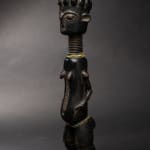Asante Wooden Sculpture of a Woman, 20th Century CE
Wood and Beads
56.5 x 10.2 cm
22 1/4 x 4 in
22 1/4 x 4 in
PF.5285 (LSO)
Further images
-
(View a larger image of thumbnail 1
)

-
(View a larger image of thumbnail 2
)

-
(View a larger image of thumbnail 3
)

-
(View a larger image of thumbnail 4
)

-
(View a larger image of thumbnail 5
)

-
(View a larger image of thumbnail 6
)

-
(View a larger image of thumbnail 7
)

-
(View a larger image of thumbnail 8
)

-
(View a larger image of thumbnail 9
)

This tall and attractive piece is a maternity or shrine figure made by the Asante group. Its basic design is reminiscent of the famous Akua’ba dolls also made by the...
This tall and attractive piece is a maternity or shrine figure made by the Asante group. Its basic design is reminiscent of the famous Akua’ba dolls also made by the Asante, but the tall coiffure, substantial body and cylindrical format mark it apart from these personalized fertility idols. The hairstyle is itself unusual, and is similar to the formats adopted by the Fante – an Akan subgroup living on the fringes of the Asante homeland. The detailing is exquisite, with slightly flexed knees, delicate arms, keloid scarifications, ringed neck and serenely reductivist facial features. The piece has a dark, shiny patina, and is additionally decorated with trade beads around the neck and waist.
The Ashanti/Asante are one of several groups that make up the Akan polity of what was once the Gold Coast (now Ghana). Their society is highly ritualised, with numerous gods under the main deity Onyame (the Supreme One). Asante society is ruled by Asantahenes and a host of minor chiefs who claim royal status through their connection with the land.
The Ashanti are Ghana’s greatest artistic force. Their Akuaba dolls are one of the most recognisable art forms on the continent, while their fascination with gold (which is considered to be a physical manifestation of life’s vital force, or “kra”) has given rise to a plethora of artefactual and artistic production. Their religious and ritualised art is balanced by secular pieces that echo the great life-observer sculptors of other tribes such as Thomas Ona of the Yoruba. Yet they also incorporate socially significant elements that are not immediately observable, but which mark out the traditional skills of Asante carvers.
This piece is probably an Esi Mansa figure, displayed in homes to demonstrate the wealth and fecundity of the inhabitants. It is recognisably Asante but is also sufficiently different to justify a place in any good collection of African art; at the same time, it would fit well into any sophisticated domestic interior. This is an excellent piece of Asante art.
The Ashanti/Asante are one of several groups that make up the Akan polity of what was once the Gold Coast (now Ghana). Their society is highly ritualised, with numerous gods under the main deity Onyame (the Supreme One). Asante society is ruled by Asantahenes and a host of minor chiefs who claim royal status through their connection with the land.
The Ashanti are Ghana’s greatest artistic force. Their Akuaba dolls are one of the most recognisable art forms on the continent, while their fascination with gold (which is considered to be a physical manifestation of life’s vital force, or “kra”) has given rise to a plethora of artefactual and artistic production. Their religious and ritualised art is balanced by secular pieces that echo the great life-observer sculptors of other tribes such as Thomas Ona of the Yoruba. Yet they also incorporate socially significant elements that are not immediately observable, but which mark out the traditional skills of Asante carvers.
This piece is probably an Esi Mansa figure, displayed in homes to demonstrate the wealth and fecundity of the inhabitants. It is recognisably Asante but is also sufficiently different to justify a place in any good collection of African art; at the same time, it would fit well into any sophisticated domestic interior. This is an excellent piece of Asante art.








